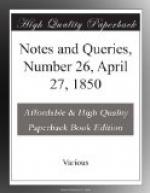Gopelin, also, in his Recherches sur la Geographie des Anciens, speaking of this part of Hanno’s voyage, says:
“Hanno encountered a troop of Ourang-outangs, which he took for savages, because these animals walk erect, often having a staff in their hands to support themselves, as well as for attack or defence; and they throw stones when they are pursued. They are the Satyrs and the Argipani with which Pliny says Atlas was peopled. It would be useless to say more on this subject, as it is avowed by all the modern commentators of the Periplus.”
The relation we have is evidently only an abridgment or summary made by some Greek, studious of Carthaginian affairs, long subsequent to the time of Hanno; and judging from a passage in Pliny (I. ii. c. 67.), it appears that the ancients were acquainted with other extracts from the original, yet, though its authenticity has been doubted by Strabo and others, there seems to be little reason to question that it is a correct outline of the voyage. That the Carthaginians were oppressors of the people they subjugated may be probable; yet we must not, on such slender grounds as this narration affords, presume that they would wantonly kill and flay human beings to possess themselves of their skins!
S.W. Singer
April 10. 1850.
* * * * *
FOLK LORE.
Cook-eels.—Forby derives this from coquille, in allusion to their being fashioned like an escallop, in which sense he is borne out by Cotgrave, who has “Pain coquille, a fashion of an hard-crusted loafe, somewhat like our stillyard bunne.” I have always taken the word to be “coquerells,” from {413} the vending of such buns at the barbarous sport of “throwing at the cock” on Shrove Tuesday. The cock is still commonly called a cockerell in E. Anglia. Perhaps Mr. Wodderspoon will say whether the buns of the present day are fashioned in any particular manner, or whether any “the oldest inhabitant” has any recollection of their being differently fashioned or at all impressed. What, too, are the “stillyard buns” of Cotgrave? Are they tea-cakes? The apartment in which tea was formerly made was called the still-room.
Buriensis.




